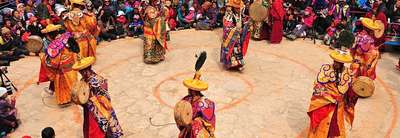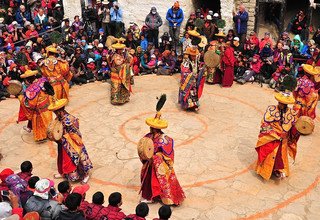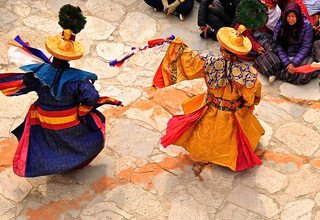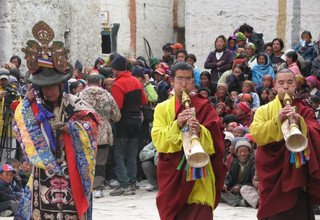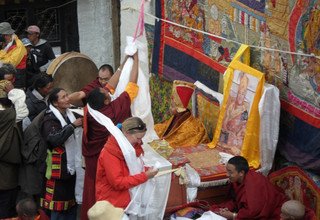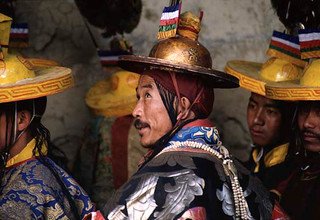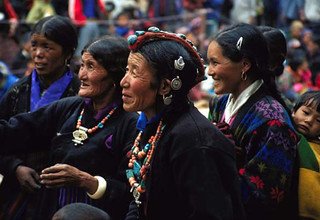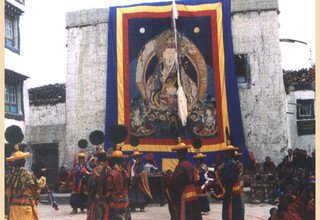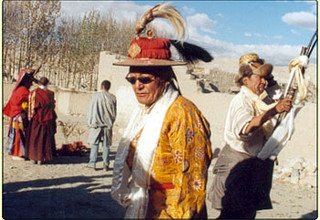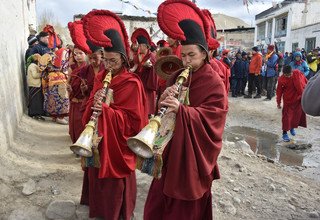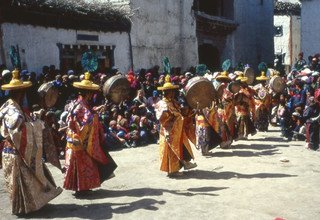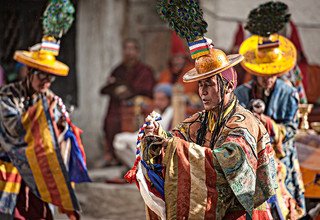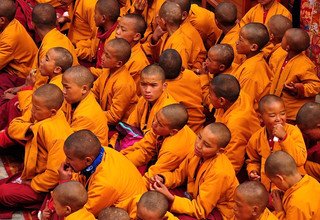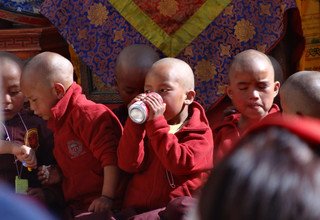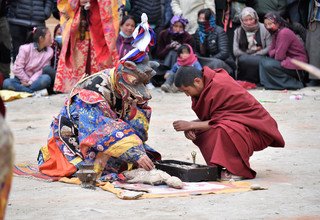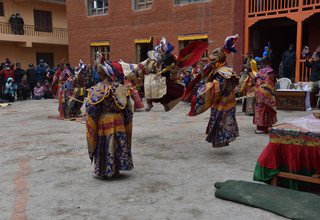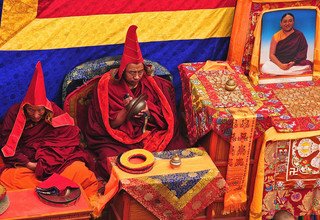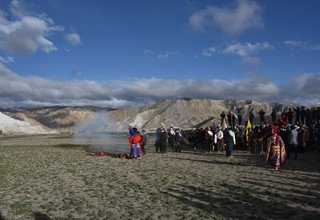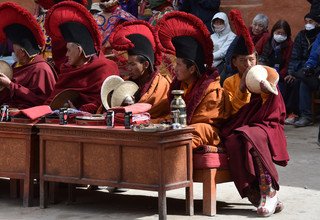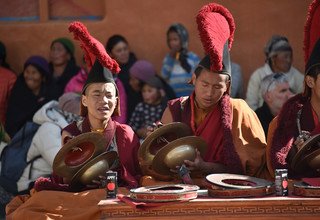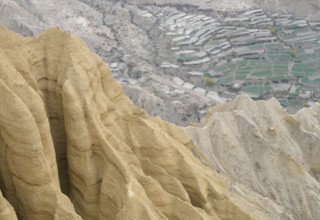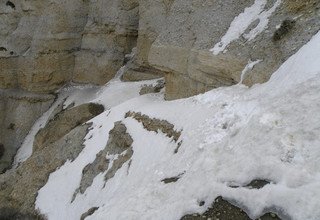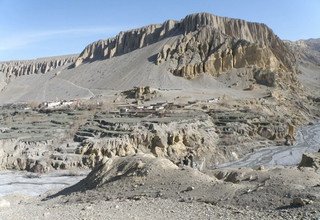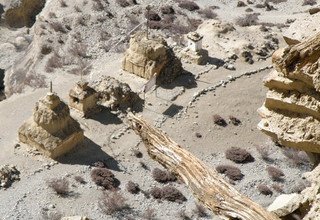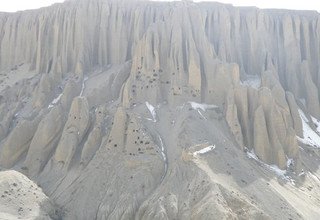Days: 12 / Difficulty: 3 of 5 (Moderate to strenuous)
Min Group Size: 2 /
Max Group Size: 14
Introduction to Tenchi/Tiji Festival Trek in Upper Mustang
This is one of the most popular trekking destinations for the traveler who would like to explore ancient monasteries and caves in a remote area and a beautiful landscape. This is the forbidden kingdom and ancient wall city of Mustang and it is open for trekkers since 1992. This trek is very enjoyable due to its isolation and beautiful landscape. Mustang is a land where the soul of the man is still considered to be as real as the feet he walks on; a land said to be ‘barren as a dead deer” but where beauty and happiness about in spite of hardships. Mustang is a remote, semi-independent Tibetan kingdom within the territory of Nepal (just north of the Annapurna Region on the Tibetan border), and one of the last bastions of undisturbed Tibetan culture in the world. The king of Mustang still ruling, their people. Massive Buddhist monasteries and nunneries are built into forbidding cliffs and mountain ledges and the starkly beautiful, windy, arid Tibetan plateau is unbroken for many hours of trekking or riding on, horseback. The trek enters upper Mustang at Kagbeni, a quaint medieval town nestled in apple orchards and encircled by Snow Mountains. It eventually reaches the ancient capitol of Lo- Manthang, a walled city built of whitewashed mud bricks and teeming with Buddhist prayer wheels and Stupas, seeming to arise from the earth itself. There are very few guesthouses and restaurants in the region; so camping is required and most necessities must be carried in. The Mustang, entirely closed to visitors until the early 1990s, upper Mustang treks are still restricted by a set of rules for cultural conservation and require a minimum $500 permit fee for a ten-day trek. (Treks are typically ten days but can be longer.) The high winds, altitude and cold add to the challenge of this trek. It is not recommended to do in the winter months and can be strenuous for some people even in the warmer months. The Mustang trek is better to do in summer season. The trek is generally moderate to strenuous as camping between 2,750m (9,000ft) to 3690m (12,100ft) and hiking to a maximum of 4,207m (13,800ft). Fully supported trek with all meals and equipment led by experienced local guide. All equipment and luggage will be carried by porters. Clients carry day pack only and walk at an easy pace. Enjoy walking with fresh natural air. Life in Mustang revolves around tourism, animal husbandry and trade. Mustang is also known as "Tibet outside the Tibetan Border" for it survived the Chinese invasion of 1951 and hence fosters much original Tibetan culture, although it is now politically part of Nepal and, except for a nine km portion from Chhuksang to Syangboche (just south of Ghiling as of August 2010, it is bisected by a new road linking it to Tibet to the north and to the rest of Nepal to the south.
History
Mustang was once an independent kingdom, although closely tied by language and culture to Tibet. From the 15th century to the 17th century, its strategic location granted Mustang control over the trade between the Himalayas and India. At the end of the 18th century the kingdom was annexed by Nepal. Though still recognized by many Mustang residents, the monarchy officially ceased to exist on October 7, 2008 by order of the Government of Nepal. The last official and current unofficial king (Raja or Gyelpo) is Jigme Dorje Palbar Bista (born.1933), who traces his lineage directly back to Ame Pal, the warrior who founded this Buddhist kingdom in 1380. Ame Pal oversaw the founding and building of much of the Lo and Mustang capital of Lo Manthang, a walled city surprisingly little changed in appearance from that time period.
The Walled City
Welcome to the only living Walled City of Nepal. Built in 1380 AD, by the first King of Lo-Manthang Ame Pal, the walled city still stands as a testimony to Lo-Manthang's prosperity and rich culture heritage. The wall, which is 2472 feet long and 26 feet high, has a series of 14 towers along its periphery. These towers rise 40 feet high & are 6 feet wide at the top. During the reign of the Mustangi Rajas, the towers were guarded by armed guards to defend the town from bandits and enemies. The only entrance to the town is through a huge wooden gate located to the east of the township. In early days, this gate was closed before dusk and opened at dawn. Until recently, the town inhabitants followed this rule dutifully, but the rule is no more in practice. Nonetheless, as in the past, expect for the Raja (King), dismount their horses while passing through the town gate. This custom is observed to pay respect to Avalokiteshwara (God of compassion), Mahne (Prayed wheel) and Jhong Lha (Deity of the fort) that are located in front of and above the Mahne respectively. The Raja, Rani and the Khempo considered as equals to the deities are not required to dismount their horses while entering the gate.
The city is divided into four traditional wards (Si-Shu), namely “Ghun-thang”, “Domaling”, “Potaling” and “Jhythang”. These names refer to as the shrines of Deities from the respective wards. “Ghun-thang” is the shrine of “Tara” or “Doma”; “Potaling” the shrine of “Dipangar Buddha” or “Hyepo Mehe”, and “Jhythang” the shrine of “Jhampa” or “Maitria, the future Buddha. These wards take turn to perform various religions and social of the town.
People of Mustang
About 1100 Lobas (people of Lo), live the 180 mud houses of the walled city, and surprisingly, they observed a form of caste-hierarchy. This may be the reason why it is mainly Kudak (Bista- the nobility & royalty of Lo) and the Phalwa (Gurung) who live within the walled city. Ghara (black smith), Shemba (butcher) and Emeta (musician) mostly live in the settlement beside the Lo-Manthang River that flows to the east of the city. The Raja and Rani of Mustang live in “Monkhar” - the four storied white-washed palace located in the middle of the town. The palace was believed to be built by the first King of Mustang, Ame Pal, in the early 14th century. The present Raja is his twenty-second descendent. Livestock husbandry combined with agriculture is still the mainstay of the economy. Seasonal migration for trade to the southern parts of Nepal and North India and barter Trade with neighboring Tibet supplements household income. With the advent of tourism in Lo in 1992, few local people have also started taking up tourist as a new economic profession. To prevent fragmentation of family property, some Lobas still practice Polyandry. A woman is married to all the brothers of a family.
Cultural and Religion
Lo-Manthang's culture is deep rooted in the religious sentiments of its people. The township abounds with many Chhortens, Mani-walls and Monasteries. Prayer flags flutter above all the houses-conveying mantras to all corners of the world. The Lobas are exclusively Buddhists and conform to the Sakya-pa sect of Tibetan Buddhism. Bon prevailed before Buddhism, which was later replaced by Ningma Pa Sect (Dhakar-Kayu sub sect) and subsequently by Sakya Pa Sect (Sakyapa, Ngorpa sub sects) of Buddhism. Of the three Gompas in Lo-Manthang, the Jhampa Gompa is the oldest. It was built in 1387 AD during the reign of the famous king Anguin Sangbo and is believed to be a replica of Ghangtse Jhampa Gompa of Tibet, which still exists in Ghangtse, near Lhasa. The three storied Jhampa Gompa is an exemplary piece of art. It amply exhibits Lo-Manthang's great architectural depth of the past. The uniqueness of this Gompa lies in gold painted tantric Mandalas entirely covering the interiors of the wall of the first and second floors. The main prayer hall is painted with double register of Mandalas interspersed with smaller attraction. One will be surprised to know that the walls of the Gompa are 5 feet and 4 inches thick! The Gompa is 55 feet high, 150 feet long and 80 feet wide. Thupchen is second oldest Gompa of the Town. It was built in the early 15th century by Tashi Gon, the third Raja of Mustang. Despite being smaller than Jhamba, Thupchen is an equally rich archetype of Tibetan art. The main hall ‘Dukhang' has beautiful ceiling and wall paintings of natural color and gold and silver paints. The wall paintings bear various images of Buddha and other deities in different mudras. The wooden beams in Dukhang carry Buddhist mantra engraved in it and the ceiling has beautifully placed rafters. In its heyday, Thupchen was the major center of religious in Lo-Manthang. Resided by the Khempo, Chhaede Gompa presently is the main Gompa of Lo and also the center of religious activity. It was built by a King named Aham Tshewang Phuntsok Tskgyen Norbu in 1757. The present Chhoede Gompa is a merger of the then Choprang Gompa and Dhakar-Thungling Chhoede Gompa. This Gompa houses beautiful Thangka (Buddhist religious paintings) and images, including the sacred Thangka of Mahakala and Dorje Sonnu (Vajra Kilas). Mahakala is a wrathful manifestation of Avalokiteshwara and Dorje Sonnu is main deity of the Tenji festival. Tenji is the most popular festival of Lo Tsho Dhun, and is celebrated over three days to mark the killing of a demon by Dorje Sonnu, the demon's son. Tenji is a derivation of the Tibetan word “Tempa Chirim”, meaning a prayer for world piece. The festival is celebrated on the fifth month of the Tibetan lunar calendar, which usually come to place in May. Two huge Thangkas are displayed during the occasion. Numerous other festivals are celebrated throughout the year. Some important ones are Mhane Dance (which marks the killing of a demon through a dance drama), Sakaluka (seed sowing ceremony for good harvest), Duk chu (Monk's dance and prayer for a prosperous New Year), Chug Emma (House hold prays for a prosperous New Year), Phakne (group of same age visit different holy places), Loshar (New Year) and so forth. A Monastic School- Tse Chhen Shedrubling Tukling Mon Gon Lobdra — is attached to the Chhoede Gompa. This is the only Sakya-pa monastic school of Upper Mustang where young monks (Dhawa) are taught on the teachings of Buddha. There are about 90 monks currently studying in this center. The people of Lo have for long relied on traditional herbal medicines to cure ailments and the faith still holds true. With some donor support, an Amchi school now runs in Lo under the Management of the local Amchi family (Tibetan Herbal Doctor).
Geography
The main hydrographic feature of Mustang is the Kali Gandaki River. The river runs southward towards Nepal Terai, bisecting Mustang. Routes paralleling the river once served as a major trade route between Tibet and India, especially for salt. Part of the river valley in the southern Mustang District forms by some measures the deepest gorge in the world. Traditional Mustang (the Lo Kingdom) is 53 km north-south at its longest and 60 km east - west at its widest, and ranges from a low point of 2750 m above sea level on the Kali Gandaki River just north of Kagbeni to 6700 m (Khamjung Himal, a peak in southeast Mustang.)
Tenchi (Tiji) Festival
The Tenchi festival is annual event indigenous to Lo-Manthang, Upper MUSTANG in Nepal. Tenchi commonly pronounced "Tiji" is the abbreviated from of Tempa Chhirim which translates to "Prayer for World peace". Tenchi commemorates the victory of Buddha's incarnation. Dhorje Sonam over a demon called Ma Tam Ru Ta, who was man eater and who caused storms and droughts to destroy people's houses and livestock. The dances performed by the monks of Lomanthang Chhyode Gumba during these three days festival enact the harassment of the Ma Tam Ru Ta, the birth of Dhorje Sonam the demon’s son and attempt by Dhorje Sonam to return the demon to the BUDDHA realm. The monks perform a dance called “Tsa Chham” on the first day of the Tenchi and “Nga Chham” on the second day, one monk has to stay in seclusion for three monks during the winter preparing for the role of Dhorje Sonam. One the third day, in a ceremony called “Rha chham” this monk in the role of Dhorje Sonam throws the effigy and Tsamppa representation of Ma Tam Ru Ta. It is believed that the village is purified of evil spirits at this time. The Tenchi festival falls from 16th to 18th days of third month of Tibetan calendar (14th-16th May of 2026). It is organized by Chhyode Gumba which is monastery of Sakyapa sect located in Lomanthang, Upper MUSTANG. The monasteries abbot is Khempo Tashi Tenjin Rinpochhe and there is close to 35 other from Lomanthang, Nenyol and Chhoser in the monastery. Villagers from all over “Lho Tshu Dhyun” (the ancient kingdom of Lo) come to watch the dance and to participate in the accompanying festivities the villager of Lo also contribute firewood and necessary material to under take the festival.
Swiss Family Trekking and Expedition regularly organizes trek to the Himalayan Kingdom of Mustang targeting TENCHI (TIJI) Festival a three days long ritual known as" The chasing of the Demons", one of the most important festival of the region. Over the festive time monks dressed in elaborate costumes and masks perform dances and rituals that are supposed to drive away evil spirits. Dressed in their finery, people from all over Mustang gather in Lo Monthang to celebrate the Tenchi Festival.
